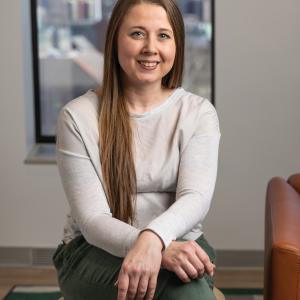Nearly $3 million in grant support from the Mellon Foundation expands opportunities for community college humanities students
A decade ago, Amber Smith knew she needed a life change. Burnt out by the restaurant business at 25 years old, she posted her belongings on Craigslist, booked a flight out of Cleveland, and moved in with a friend living in Tunisia. There, she volunteered in a school where English was taught as a secondary language and discovered a new passion. Full-time employment options were limited without a college degree, though—and she lacked the French and North African Arabic language skills needed to truly connect with students. Returning home, she knew what she wanted to do, but it wasn’t entirely clear how she would make it happen.
When she enrolled at Cuyahoga Community College (Tri-C) in 2019—13 years removed from her last experience as a student—Smith immersed herself in several languages and was quickly identified as a candidate for the Cleveland Humanities Collaborative (CHC).
Initiated in 2014 through a grant from the Mellon Foundation, the program’s framework empowers faculty to identify high-performing humanities students at Tri-C, Lakeland Community College and Lorain County Community College, and provide them with support services and learning opportunities as they transition into—and complete—bachelor's degree programs at Case Western Reserve University. The program also expands opportunities for CWRU graduate students to engage in the collaborative’s programming.
This spring, the Mellon Foundation added nearly $3 million to its previous commitments in 2014 and 2018, bringing the total to CWRU and Tri-C to over $6.5 million. The third phase of funding allows CHC Director Kurt Koenigsberger, PhD, Co-Director Brian Clites, PhD, and Associate Director Lisa Nielson, PhD, to offer enhanced advising support and on-campus summer programming for transfer students, ensuring each step moves them closer to bachelor's degrees and beyond.
“In phase three, we're also emphasizing those career pathways,” said Koenigsberger. “We want every student to have an internship opportunity pre-matriculation at Case Western Reserve, during the academic year and then during summer.”
For Smith, the collaborative’s support structure opened doors that once seemed inaccessible. “I would never have thought in a million years I would have the opportunity to go to Case Western Reserve—or even consider it,” she said. “The thought of transferring from Tri-C to CWRU wasn’t even on my radar.”
Beyond the CWRU classroom experience as a French and Francophone studies major, the collaborative provided Smith with opportunities such as micro internships teaching English as a second language; conducting research abroad, working in France with refugee families from Ukraine, Belgium, Turkey, Russia, Syria, Afghanistan and parts of Africa; and now working with the University of Nebraska and Western Reserve Historical Society transcribing letters of Cleveland author and essayist Charles Chestnutt.
Ahead of graduation this spring, Smith accepted an offer with Teach for America. When she begins this fall, she’ll be teaching math and science to Cleveland-area students in grades four through nine. It’s the first step in a career that is now firmly guided by her own hand.
“My trajectory when I started at Case Western Reserve was completely different than where it is now. I see the world being my oyster for years to come and I'm so grateful for the Mellon Foundation for funding this program,” she said. “I hope to see this program continue in the future for other locals like me who always admired CWRU but never saw themselves as someone who could actually be there.”
CWRU material
Since the collaborative began accepting applicants in 2016, 55 students have been accepted, with 47 matriculating to Case Western Reserve—accounting for nearly 10% of the university’s transfer students and 63% of all humanities transfers. Like Smith, Jose Fontanez never imagined he’d be one of them.
When a Tri-C professor mentioned the Cleveland Humanities Collaborative in class, Fontanez dismissed it—twice. “I didn’t think I was ‘Case Western Reserve material,’” he said.
On the third attempt, the professor challenged him directly to apply. Fontanez considered himself a "non-traditional student." He struggled in high school and had a disjointed start to his college career, so he was skeptical about transferring to CWRU.
"But [the professor] was familiar with my progress," he said, "and asked: ‘Who do you think gets into these programs?’ That froze me in my tracks.”
Fontanez, who transferred from Tri-C with an Associate of Arts degree, is working to obtain English and education degrees at CWRU and aspires to teach high school English. Before he graduates in the spring of 2025, he’ll spend a semester as a student teacher at Brush High School in Lyndhurst, Ohio.
“The leaders of the collaborative go out of their way to make sure the students have real, meaningful experiences in the professional world prior to graduation—and that’s tremendously beneficial to people who are moving out of the classroom and into a professional setting.”
For Fontanez, the partnership between Tri-C and CWRU was exactly what he needed. “This turns out to be,” he said, “where I belonged all along.”
Originally published in the summer 2024 issue of Forward Thinking magazine



